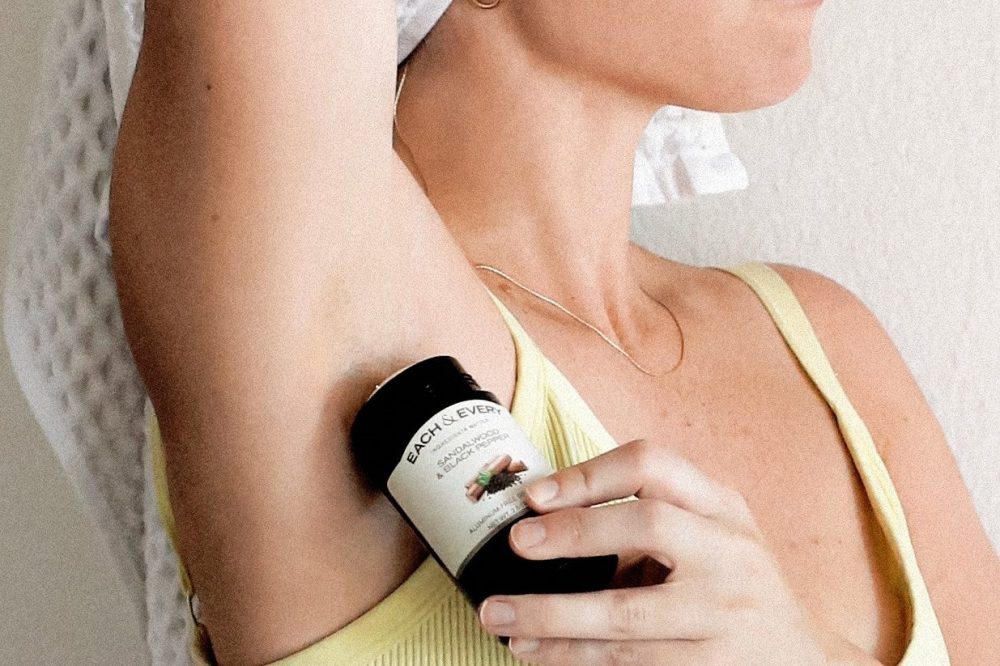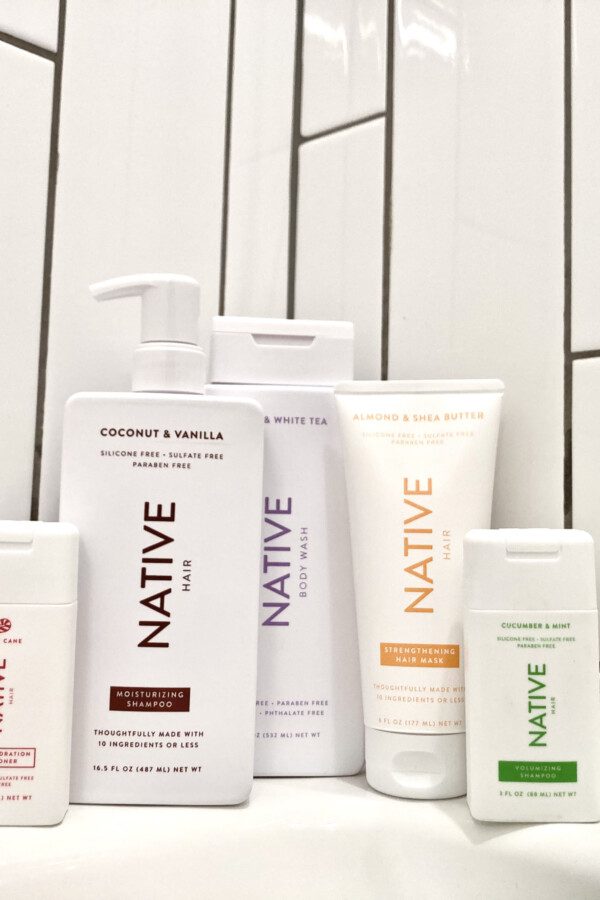If you’ve switched (or tried to switch) to natural, non-toxic deodorant, there are two common ingredients you may have noticed in many brands: sodium bicarbonate (a.k.a baking soda) and magnesium hydroxide (a.k.a. salt).
There’s a bit of controversy about whether these two ingredients are actually good for your skin. So, we investigated to find out the pros and cons of using baking soda and magnesium hydroxide in deodorant.
Table of Contents
- Why is Baking Soda Used in Deodorant?
- Baking Soda: THE PROS
- Baking Soda: THE CONS
- Can You Use Just Baking Soda As Deodorant?
- What is Magnesium Hydroxide?
- Why is Magnesium Hydroxide Used in Deodorant?
- Magnesium Hydroxide: THE PROS
- Magnesium Hydroxide: THE CONS
- Are Baking Soda & Magnesium Hydroxide Safe?
- Do These Ingredients Actually Work?
- Non-Toxic, Baking Soda-Free Deodorant Brands
- The Best Non-Toxic Deodorant Brands That Use Baking Soda
- Other Active Ingredients in Natural Deodorant
- What Ingredients Should I Avoid in Deodorant?
- Conclusion
Why is Baking Soda Used in Deodorant?
Baking soda is really good at absorbing moisture, which is one of the primary reasons it’s included in a lot of natural deodorants. Not only that, but it’s also basic, which means that it creates a pH environment on your skin that is too alkaline for odor-causing bacteria to thrive.
Baking Soda: THE PROS
Baking soda has antibacterial properties and is really good at absorbing sweat, making it a very effective ingredient in dealing with both moisture and body odor.
It’s also widely used, so you’ve got a lot of choices. It’s pretty easy to find effective, non-toxic deodorants that utilize baking soda and come in a wide variety of scents, price ranges, and more.
Baking Soda: THE CONS
The thing that makes baking soda effective against bacteria is also the same thing that makes it irritating for some individuals’ skin. The pH of baking soda is too high for bacteria, but it’s also higher than the natural pH of your skin, which can lead to armpit irritation and redness for some people.
Can You Use Just Baking Soda As Deodorant?
Some people actually create their own D.I.Y. deodorant recipe with baking soda, or even go as far as putting baking soda directly on the skin. But is this a good idea? What happens if you put baking soda on your armpits?
Well, we can’t really recommend it. Most natural deodorants contain a lower concentration of baking soda than what you’d likely put on your pits with your own recipe. Not only that, but most natural deodorants are formulated with other ingredients that counteract the potentially negative effects of baking soda. Coconut oil, for example, is acidic, which means it can help to balance out the pH of the baking soda while also providing essential nutrients and fatty acids to soothe and heal the skin.

What is Magnesium Hydroxide?
It might sound like a complicated name, but magnesium hydroxide is actually just a kind of salt! (Although, it’s a different kind from the typical table salt that may initially come to mind.)
You may have heard of milk of magnesia, which is sometimes used internally to relieve occasional constipation, indigestion, and heartburn. This is made of magnesium hydroxide too. Some people actually apply milk of magnesia to their armpits for a sort of D.I.Y. deodorant. We don’t really recommend this though, because (just like with the D.I.Y. baking soda deodorant) using milk of magnesia alone means you’re missing out on a lot of the other beneficial ingredients in a more comprehensively formulated natural deodorant.
Why is Magnesium Hydroxide Used in Deodorant?
Magnesium hydroxide (or more generically, just “magnesium”) is used in deodorant for the same reason baking soda is: to create a pH environment on the skin that’s too high for odor-causing bacteria to thrive.
Magnesium Hydroxide: THE PROS
Since it’s alkaline, magnesium hydroxide also has antibacterial properties just like baking soda does. This is what makes it effective against odor.
Compared to baking soda, however, magnesium hydroxide is less water-soluble. That means it acts as a “slow-release” ingredient, taking longer to fully dissolve and absorb your sweat. This is a good thing because it doesn’t disrupt the natural pH of your underarm skin so drastically, meaning there’s less potential for irritation when compared to baking soda.
This “slow-release” property also means it’s likely to stay active and working for a longer period of time compared to baking soda.
Magnesium deodorants are also widely available in different scents, price ranges, formats, and more, so you’re likely to find something that fits your preferences.
Body
Is Dove Deodorant Safe? (Let’s Investigate!)
With its clean aesthetic and feel-good campaigns, Dove seems like a great brand that cares about its customers’ health and wellbeing. But do its ingredient labels align with the brand’s messaging? We’re taking a deep dive into the ingredients in all of Dove’s varieties of deodorant to find out just how safe these personal care products really are.
Magnesium Hydroxide: THE CONS
Because of its high pH, magnesium hydroxide comes with similar potential issues that baking soda does: it can alter the natural pH of your underarm skin in a way that may cause redness or irritation for some people. BUT, as mentioned above, there is less risk for irritation compared to baking soda.
Magnesium hydroxide is not as effective at absorbing moisture as baking soda, so it’s often combined with other sweat-fighting ingredients such as arrowroot powder or corn starch.
Are Baking Soda & Magnesium Hydroxide Safe?
Although some individuals may experience irritation or redness from baking soda and/or magnesium hydroxide, the good news is that the potential problems of these two ingredients stop there. They are otherwise non-toxic and have not been linked to any more long-term, serious health conditions like cancer, infertility, developmental disorders, environmental toxicity, etc.
So, as long as your deodorant is not causing any pit discomfort, you can feel perfectly safe using products containing either or both of these ingredients.
Body
Deodorant for Sensitive Skin (The Best 12 Brands for 2024)
Irritated pits? Here’s what could potentially be causing your armpit irritation, what to do about it, and the list of the best deodorant for sensitive skin.
Do These Ingredients Actually Work?
There are so many things that can affect how much one sweats and smells: genetics, medical conditions, level of exercise, diet, and more. For this reason, there is no one-size-fits-all when it comes to deodorant.
For many people, natural deodorant that uses baking soda and/or magnesium hydroxide for its active ingredient(s) is just as (or almost as) effective as “conventional” deodorants. However, many people do require a “transition period” when switching to natural deodorant. You may need to get rid of built-up bacteria, skin cells, silicones, and other ingredients that may be clogging your pores and keeping you stinky. Check out this article for how to deal with clogged pores and do an armpit detox. You may have to do some trial and error to find a natural deodorant that really works for you!
This post may contain affiliate links, which means we may earn a small commission if you choose to make a purchase. We only make recommendations that are genuine and meet our ingredient/material safety standards.

Non-Toxic, Baking Soda-Free Deodorant Brands
If you do wish to skip the baking soda and choose magnesium hydroxide instead, here are some great non-toxic deodorant brands that carry a range of options to choose from.
*these brands have both baking soda and baking soda-free versions available
The Best Non-Toxic Deodorant Brands That Use Baking Soda
While some people with sensitive skin choose to stay away from baking soda, others actually prefer it because it’s the only thing that actually works for them! Here are a few of the best deodorant brands that utilize the powerful, odor-fighting effects of sodium bicarbonate:
- Primally Pure
- PiperWai
- Soapwalla
- Earth Mama
- Tierra & Lava
- All Good
- Alpine Provisions
- Plum Brilliance
- Meow Meow Tweet*
- Agent Nateur*
- Attitude*
- Fat & The Moon*
*these brands have both baking soda and baking soda-free versions available

Other Active Ingredients in Natural Deodorant
Baking soda and magnesium aren’t the only active ingredients that are utilized by deodorant brands. Other odor-fighting and moisture-absorbing ingredients to look out for include:
- Arrowroot powder
- Corn starch
- Tapioca starch
- Activated Charcoal
- Acid Toners
- Witch Hazel
- Probiotics
- Zinc
What Ingredients Should I Avoid in Deodorant?
At the end of the day, both baking soda and magnesium are much better ingredients than a LOT of the other ingredients that are found in conventional deodorants and antiperspirants. These are some of the worst ingredients that should be avoided if possible:
- Aluminum
- Parabens
- Phthalates
- Fragrance / Parfum
- Talc
- PEGs
You can check out this article about deodorants for sensitive skin as well as this investigation into Dove deodorants for a more in-depth look into these common toxicants.
Conclusion
Baking soda and magnesium hydroxide are two very common deodorant ingredients that help to prevent and combat body odor and absorb sweat. The thing that makes them so effective against odor-causing bacteria is unfortunately the same thing that can cause skin irritation for some people. In general, baking soda tends to perform better in fighting odors, while magnesium hydroxide is gentler on the skin and comes with less risk of irritation.
There are plenty of brands that carry a variety of deodorants, so don’t be afraid to do some trial and error and see what works best for you!
Image credits: Pavel Neznanov, Ketut Subiyanto, product images belong to respective brands







There is some wonderful information here, but I think one line is a bit misleading: saying that magnesium hydroxide is ‘just salt’ is incorrect. When reading this, many people will assume it is the same as table salt — sodium chloride — which it obviously is not, since it is made up of completely different chemical elements. Magnesium hydroxide is *a* salt, but the family of chemical salts is so large and diverse that no useful information can be derived from that statement alone.
I think that line should be removed or modified (i.e. more information given about what *type* of salt magnesium hydroxide is) so as not to give people the wrong impression. Otherwise, great article, I got some really useful information here.
Great point – thanks for pointing that out, Brent! We’ve clarified this part of the article. 🙂